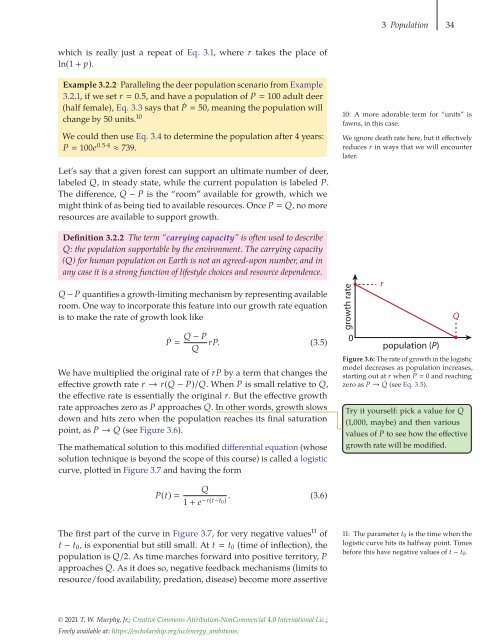Energy and Human Ambitions on a Finite Planet, 2021a
Energy and Human Ambitions on a Finite Planet, 2021a
Energy and Human Ambitions on a Finite Planet, 2021a
Create successful ePaper yourself
Turn your PDF publications into a flip-book with our unique Google optimized e-Paper software.
3 Populati<strong>on</strong> 34<br />
which is really just a repeat of Eq. 3.1, where r takes the place of<br />
ln(1 + p).<br />
Example 3.2.2 Paralleling the deer populati<strong>on</strong> scenario from Example<br />
3.2.1, ifwesetr 0.5, <str<strong>on</strong>g>and</str<strong>on</strong>g> have a populati<strong>on</strong> of P 100 adult deer<br />
(half female), Eq. 3.3 says that Ṗ 50, meaning the populati<strong>on</strong> will<br />
change by 50 units. 10<br />
We could then use Eq. 3.4 to determine the populati<strong>on</strong> after 4 years:<br />
P 100e 0.5·4 ≈ 739.<br />
Let’s say that a given forest can support an ultimate number of deer,<br />
labeled Q, in steady state, while the current populati<strong>on</strong> is labeled P.<br />
The difference, Q − P is the “room” available for growth, which we<br />
might think of as being tied to available resources. Once P Q, no more<br />
resources are available to support growth.<br />
Definiti<strong>on</strong> 3.2.2 The term “carrying capacity” is often used to describe<br />
Q: the populati<strong>on</strong> supportable by the envir<strong>on</strong>ment. The carrying capacity<br />
(Q) for human populati<strong>on</strong> <strong>on</strong> Earth is not an agreed-up<strong>on</strong> number, <str<strong>on</strong>g>and</str<strong>on</strong>g> in<br />
any case it is a str<strong>on</strong>g functi<strong>on</strong> of lifestyle choices <str<strong>on</strong>g>and</str<strong>on</strong>g> resource dependence.<br />
Q − P quantifies a growth-limiting mechanism by representing available<br />
room. One way to incorporate this feature into our growth rate equati<strong>on</strong><br />
is to make the rate of growth look like<br />
Ṗ Q − P rP. (3.5)<br />
Q<br />
We have multiplied the original rate of rP by a term that changes the<br />
effective growth rate r → r(Q − P)/Q. When P is small relative to Q,<br />
the effective rate is essentially the original r. But the effective growth<br />
rate approaches zero as P approaches Q. In other words, growth slows<br />
down <str<strong>on</strong>g>and</str<strong>on</strong>g> hits zero when the populati<strong>on</strong> reaches its final saturati<strong>on</strong><br />
point, as P → Q (see Figure 3.6).<br />
The mathematical soluti<strong>on</strong> to this modified differential equati<strong>on</strong> (whose<br />
soluti<strong>on</strong> technique is bey<strong>on</strong>d the scope of this course) is called a logistic<br />
curve, plotted in Figure 3.7 <str<strong>on</strong>g>and</str<strong>on</strong>g> having the form<br />
10: A more adorable term for “units” is<br />
fawns, in this case.<br />
We ignore death rate here, but it effectively<br />
reduces r in ways that we will encounter<br />
later.<br />
growth rate<br />
0<br />
r<br />
populati<strong>on</strong> (P)<br />
Figure 3.6: The rate of growth in the logistic<br />
model decreases as populati<strong>on</strong> increases,<br />
starting out at r when P 0 <str<strong>on</strong>g>and</str<strong>on</strong>g> reaching<br />
zero as P → Q (see Eq. 3.5).<br />
Q<br />
Try it yourself: pick a value for Q<br />
(1,000, maybe) <str<strong>on</strong>g>and</str<strong>on</strong>g> then various<br />
values of P to see how the effective<br />
growth rate will be modified.<br />
P(t) <br />
Q<br />
1 + e −r(t−t 0) . (3.6)<br />
The first part of the curve in Figure 3.7, for very negative values 11 of<br />
t − t 0 , is exp<strong>on</strong>ential but still small. At t t 0 (time of inflecti<strong>on</strong>), the<br />
populati<strong>on</strong> is Q/2. As time marches forward into positive territory, P<br />
approaches Q. As it does so, negative feedback mechanisms (limits to<br />
resource/food availability, predati<strong>on</strong>, disease) become more assertive<br />
11: The parameter t 0 is the time when the<br />
logistic curve hits its halfway point. Times<br />
before this have negative values of t − t 0 .<br />
© 2021 T. W. Murphy, Jr.; Creative Comm<strong>on</strong>s Attributi<strong>on</strong>-N<strong>on</strong>Commercial 4.0 Internati<strong>on</strong>al Lic.;<br />
Freely available at: https://escholarship.org/uc/energy_ambiti<strong>on</strong>s.


















